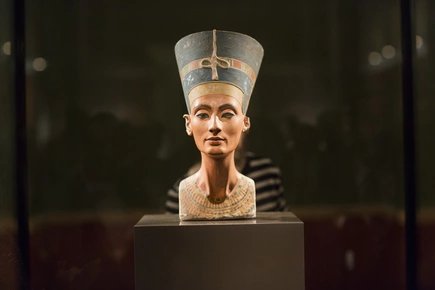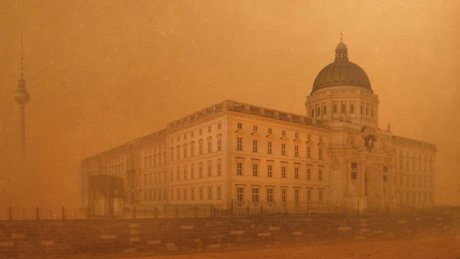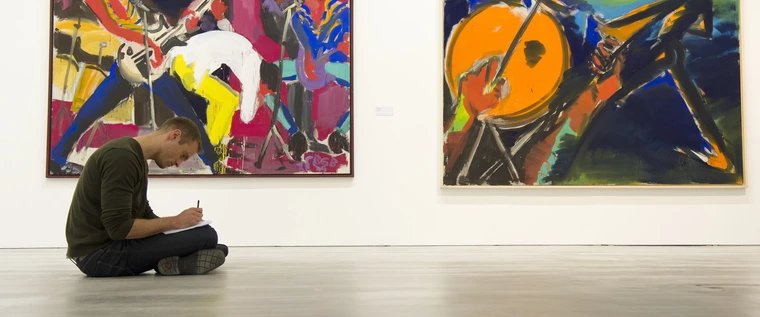
Opening weekend of the exhibition ‘On Water’ from 9 to 12 October 2025
The opening weekend of the exhibition ‘On Water’ from 9 to 12 October 2025 will focus on the ‘colours of water’. Although water is usually depicted as blue, it actually comes in a wide variety of shades – such as grey, black or red. Many of these colours have specific meanings or serve as technical designations.
Taking up the multicoloured nature of the wet element, the colourful opening weekend will focus on three of these colours and their associations: on Friday on rivers (green water), on Saturday on water in the city (purple water) and on Sunday on drought (brown water).
Brown Water
Where water is scarce, blue, green, and silver disappear from the landscape. What remains are shades of brown and cracked soil. However, drought also challenges our ingenuity: How can we live, design, and manage with less water? What proven and new ways are there to store, share, and use water sustainably?
This day will focus on techniques and historical experiences in dealing with drought, on the knowledge we can gain from particularly water-scarce regions of the world, and on strategies—from traditional water storage to modern sponge cities — that help to overcome the shortage.
Programme
10:30–12:30: The future of water – workshop with futurologist Sascha Dannenberg
How is climate change affecting our waters? How will our rivers react when Lusatia dries up? And will we be swimming everywhere in the city in the future? In an interactive workshop with futurologist Sascha Dannenberg from Freie Universität Berlin, participants will develop various future scenarios for water in Berlin.
(In German)
11:30–12:30: On Water – Family Tour
What does it sound like when a tree drinks? How are people around the world coping with increasing drought? What does a puddle researcher do? And how do you study water on Mars?
The exhibition ‘On Water’ at the Humboldt Lab showcases research projects by Berlin scientists on the topic of water. In a 60-minute tour that takes them from the sea to an artificial iceberg to the stars, children and families learn about the diversity of scientific research on the wet element and the water-related challenges in times of climate crisis.
Book your free ticket here.
(in German)
14:00–15:00: Meet the Scientist – Drought Research I
14:00–14:30: Indrawan Prabaharyaka: Thirst in the mangrove forest. Using design to reduce inter-species water conflicts
On the mangrove coast of Muara Gembong, a rural area near the megacity of Jakarta in Indonesia, humans and monkeys are increasingly in conflict. Rising temperatures, deforestation, and hyper-salinization are causing freshwater sources in the area to dry up. Unlike the human inhabitants, who can buy bottled water, their non-human neighbors cannot. During prolonged heat waves in the summer, some monkeys were found dead from dehydration. Others searched for water sources near fishing boats and houses, exacerbating the conflict between different species.
From 2022 to 2025, Indrawan Prabaharyaka collaborated with a multidisciplinary collective called Labtek Apung, which consists of experts in environmental technology, chemistry, architecture, art, and anthropology. Its goal was to better understand the conflict and find solutions. One result of the research is a prototype water collector that can desalinate seawater in the summer and collect rainwater during the monsoon season. While human designers view it as a water collector, non-human users seem to regard it as a toy. So how could the design be approached differently in terms of conflicts between different species?
(In English)
14:30-15:00: Salam Ebeid: What comes out of the desert sea: fish and other things!
The Red Sea in Egypt is more than a tourist destination. It is home to many tribal communities that live in the mountains and by the sea. Al Ababda struggle against many environmental stressors and “tourist development” that are impacting their traditional way of living and livelihoods. This project primarily explores different bodies of water, the traditional ways of fishing fish but Salam found that women do not only fish for fish but for other things too. Objects and items that come out of the sea are utilized in the everyday. A kind of salvage economy to curb the harshness of the ecology around living in the desert but also by the sea. Hence the sea is not only a source of fish but of other things. The sea is a source of wealth of sustenance. It gives. It expels. It has agency of its own.
(in Englisch)
15:00–16:00: Kuratorenführung “On Water”
with Daniel Tyradellis
Daniel Tyradellis, Professor of and Senior Advisor to the Curator, guides visitors through the exhibition “On Water.”
The tour starts in front of the Humboldt Lab on the first floor of the Humboldt Forum. A ticket is not required.
(In German)
16:00–17:00: Meet the Scientist – Drought Research II
16:00–16:30: Alexander Schunka: A precious commodity. Water shortages and water scarcity in pre-modern Central Europe
How did people in early modern Central Europe cope with water shortages? How did they respond to recurring periods of drought, but also to everyday water shortages? In his lecture, historian Alexander Schunka focuses on resource scarcity between 1500 and 1800, as well as contemporary forms of water management and the development of water infrastructure in inland territories. He explains his thesis that water, as a scarce commodity, was often controversial and at the same time required special forms of cooperation to ensure a minimum level of social cohesion.
(In German)
16:30–17:00: Dimitra Almpani-Lekka: Cheimarros – Cheimarros. Architectural approaches to drought and the loss of biodiversity in the city
What role can architecture play in coping with increasing drought in cities, water management problems, and the loss of urban biodiversity? Architect and biodesigner Dimitra Almpani-Lekka explores how water can be incorporated into the built environment to find solutions to extreme weather phenomena, which are becoming more frequent against the backdrop of the climate crisis. She presents how we can learn from rural and traditional architectures and biological organisms, and how the shared use of water in public spaces based on “commons networks” can contribute to a more resilient city. In her lecture, she presents “Cheimarros,” an installation created as part of the “Water-Driven Membranes” research project and made especially for “On Water.” It takes up circular processes between water and different species, as well as plant and microbial properties, as design principles, while inviting the audience to reflect on their own embodied knowledge of water.
17:00–18:00 Uhr: Sap Score – Sound art and the attempt to empathise with trees
Artist talk with Andreas Greiner and Roland Bolz
With their work Sap Score, presented in ‘On Water’, artist Andreas Greiner and philosopher and sound engineer Roland Bolz explore the acoustic inner life of trees. The sound art piece, developed for the exhibition, makes sounds audible that normally remain hidden: from the transport of water through the xylem to the diverse sounds that accumulate inside and around trees.
The discussion focuses on artistic strategies that enable a different perception of non-human beings. What role can sound art play in making nature a new experience and rethinking our relationship with it? How can the urgency of the climate crisis be conveyed aesthetically without resorting to anthropomorphisation? The audience is invited to hear and perceive trees as fellow beings in our living environment.
Moderator: Anna-Lisa Dieter
(In German)
- free admission
- 14 years and older
- German/English
- Humboldt Lab, 1st floor
- Belongs to: On Water
Additional information
Dates
October 2025
| Mo | Tu | We | Th | Fr | Sa | Su |
|---|---|---|---|---|---|---|
1
|
2
|
3
|
4
|
5
| ||
6
|
7
|
8
|
9
|
10
|
11
|
12
|
13
|
14
|
15
|
16
|
17
|
18
|
19
|
20
|
21
|
22
|
23
|
24
|
25
|
26
|
27
|
28
|
29
|
30
|
31
|



